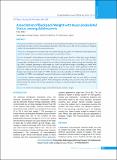Please use this identifier to cite or link to this item:
https://hdl.handle.net/20.500.14356/1321Full metadata record
| DC Field | Value | Language |
|---|---|---|
| dc.contributor.author | Kafle, Sristy | - |
| dc.date.accessioned | 2023-05-07T07:03:39Z | - |
| dc.date.available | 2023-05-07T07:03:39Z | - |
| dc.date.issued | 2020 | - |
| dc.identifier.citation | KafleS. (2020). Association of Backpack Weight with Musculoskeletal Status among Adolescents . Journal of Nepal Health Research Council, 18(3), 535-540. https://doi.org/10.33314/jnhrc.v18i3.1708 | en_US |
| dc.identifier.issn | JNHRC Print ISSN: 1727-5482; Online ISSN: 1999-6217 | - |
| dc.identifier.uri | http://103.69.126.140:8080/handle/20.500.14356/1321 | - |
| dc.description | Original Article | en_US |
| dc.description.abstract | Abstract Background: Adolescence period is a critical stage of musculoskeletal development and carrying heavy backpack to school daily puts them at risk of musculoskeletal discomfort. This study aims to find out the association of backpack weight with musculoskeletal status among adolescents. Methods: A descriptive cross-sectional study was conducted among 291 grade 4 to 8 students from three government schools of Lalitpur. Data was analyzed using descriptive and inferential statistics. Results: Around 68% of the adolescents carried schoolbag of weight greater than 10% of their body weight. Similarly, 66.7% perceived musculoskeletal pain of which 29.9% had ever missed school due to pain, 70.1% felt tired while carrying their schoolbag and 23.4% adopted forward/sideways leaning posture while carrying their schoolbag. Age (p< 0.001), backpack percentage to body weight (p< 0.001) and perceived weight of schoolbag (p= 0.006) were significantly associated with musculoskeletal pain. Similarly, age (p= 0.023), sex (p= 0.005), grade (p= 0.030) and perceived weight of schoolbag (p= 0.007) were significantly associated with tiredness while carrying schoolbag. Also, backpack percentage to body weight (p= 0.008), duration of carrying schoolbag (p= 0.010) and perceived weight of schoolbag (p= 0.001) were significantly associated with posture assumed while carrying schoolbag. Conclusions: Students carrying backpack weight more than recommended limit are more likely to develop musculoskeletal pain and change in posture while carrying their schoolbag. Thus, necessary steps must be taken to further analyze the situation and develop management strategies on reducing backpack weight and its possible effect on adolescents. Keywords: Adolescents; backpack weight; musculoskeletal pain; tiredness, fatigue | en_US |
| dc.language.iso | en | en_US |
| dc.publisher | Nepal Health Research Council | en_US |
| dc.relation.ispartofseries | Jul-Sep 2020;1708 | - |
| dc.subject | Adolescents | en_US |
| dc.subject | Backpack weight | en_US |
| dc.subject | Musculoskeletal pain | en_US |
| dc.subject | Tiredness | en_US |
| dc.subject | Fatigue | en_US |
| dc.title | Association of Backpack Weight with Musculoskeletal Status among Adolescents | en_US |
| dc.type | Journal Article | en_US |
| local.journal.category | Original Article | - |
| Appears in Collections: | Vol. 18 No. 3 (2020): Vol. 18 No. 3 Issue 48 Jul-Sep 2020 | |
Files in This Item:
| File | Description | Size | Format | |
|---|---|---|---|---|
| 1708-Manuscript-18855-1-10-20201115.pdf | 214.38 kB | Adobe PDF |  View/Open |
Items in DSpace are protected by copyright, with all rights reserved, unless otherwise indicated.
